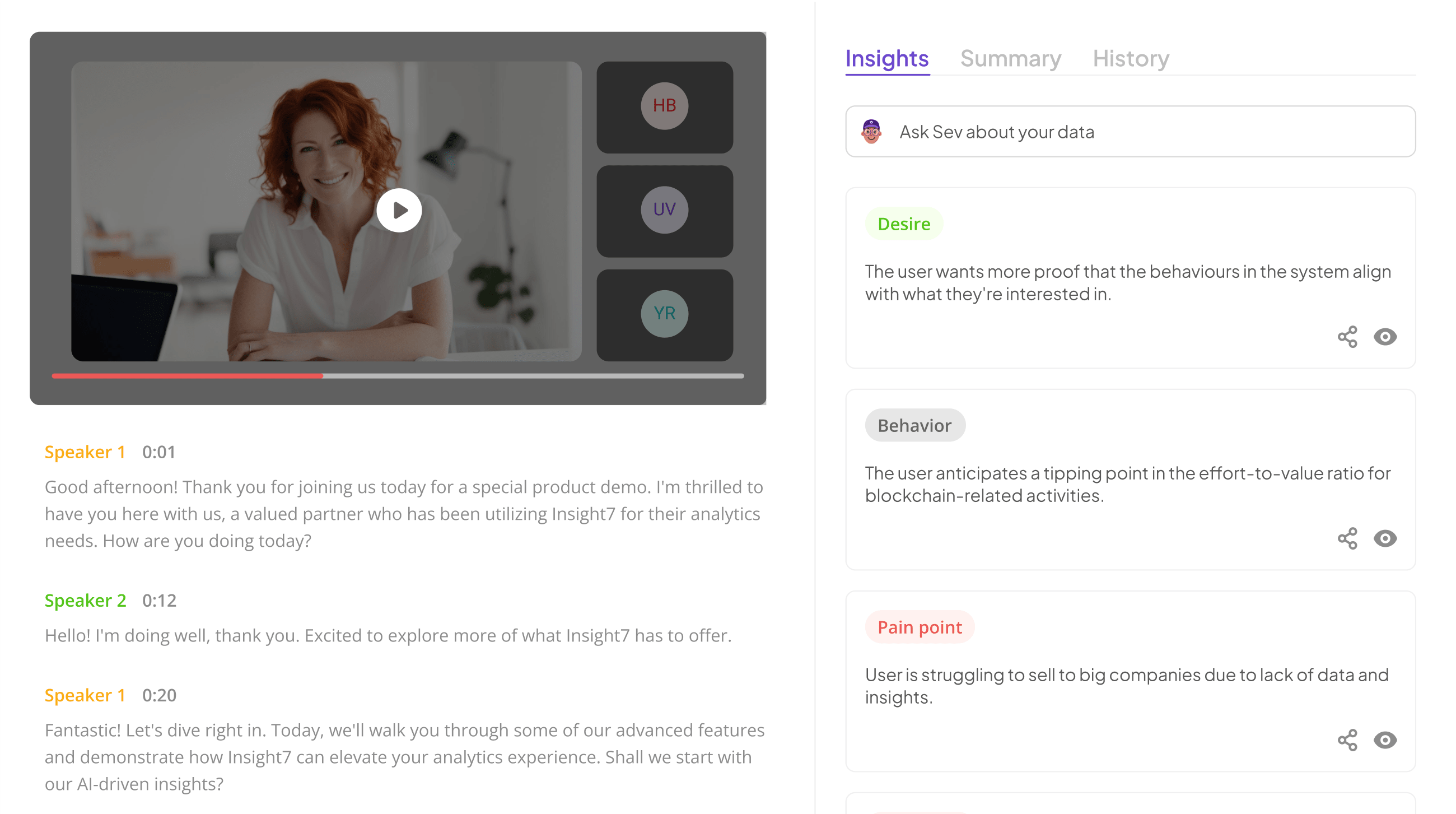Transcript Analysis: How-to & Top Tools
-
Bella Williams
- 10 min read
Transcript analysis tools are transforming how we interpret conversations, making it easier to extract meaningful insights from dialogue. In today’s data-driven world, manually sifting through transcripts is time-consuming and often ineffective. These tools streamline the analysis process by providing intuitive platforms to upload, transcribe, and mine data for critical insights.
As organizations seek to enhance their understanding of customer conversations, the demand for effective transcript analysis has grown. By utilizing these tools, users can quickly identify trends, pain points, and opportunities, all while saving precious time. Whether for sales calls or customer feedback, leveraging the right transcript analysis tools can significantly improve decision-making and strategic planning.
Analyze & Evaluate Calls. At Scale.

Understanding Transcript Analysis: How-to Guide
Understanding transcript analysis entails grasping the essential steps needed to obtain meaningful insights from recorded conversations. The first step involves preparing your transcript, which usually requires transcribing audio files into text format, making it easier to analyze. By using efficient transcript analysis tools, you can quickly convert multiple files into transcripts, laying the groundwork for deeper analyses.
Once transcripts are prepared, the next phase is to apply key techniques for effective analysis. By selecting specific insights and utilizing predefined templates, you can uncover pain points or themes relevant to your objectives. Moreover, these tools allow for easy organization and retrieval of insights from various calls, offering a structured approach to data interpretation. Thus, understanding transcript analysis equips you with the skills to derive actionable insights from your conversations, ultimately enhancing decision-making processes.
Step 1: Preparing Your Transcript
To prepare your transcript effectively, begin by gathering all relevant audio files. These might include recorded customer calls or interviews that need conversion into text. Accurate transcription is crucial as it serves as the foundation for your subsequent analysis. By using reliable tools, you can facilitate the bulk transcription of multiple files at once, ensuring you save time and effort.
Once you have your transcripts ready, organize them in a dedicated library for easy access. This organization allows you to visualize individual calls effortlessly. With your transcripts at hand, you can start extracting key insights and patterns, making the analysis both efficient and comprehensive. Don't forget to utilize specific templates to target insights related to customer feedback or sales performance. Engaging with your transcripts in this structured manner sets the stage for more in-depth analysis, leading to actionable insights that can drive your strategy forward.
Step 2: Key Techniques for Effective Analysis
Effective analysis of transcripts requires a systematic approach to derive meaningful insights. First, you should categorize the data you collected, defining the focal points, such as pain points or themes. This enables you to highlight recurring issues or suggestions within the conversation. Utilizing transcript analysis tools can also streamline this process, helping you to efficiently extract data patterns and key insights.
Next, organizing the information in an accessible format is crucial. You might choose to visualize the data, create summaries, or methodically compile themes for comprehensive reporting. For instance, presenting data through a matrix can clarify which customer concerns are most prevalent, allowing for strategic decision-making. By embracing these techniques, you can enhance your analysis and foster actionable insights that drive improvements in your projects.
Extract insights from interviews, calls, surveys and reviews for insights in minutes
Top Transcript Analysis Tools for Efficient Workflows
In today’s fast-paced environment, having the right Transcript Analysis Tools can make all the difference in your workflow efficiency. For instance, Otter.ai offers a user-friendly interface that allows you to transcribe audio files into comprehensive text formats seamlessly. This enables users to focus on extracting valuable insights instead of stressing over transcription accuracy.
Descript, on the other hand, combines transcription with powerful editing features, making it easy to manage and analyze content. Rev provides high-quality transcriptions performed by professionals, assuring accuracy for critical projects. Finally, Sonix stands out with its automatic transcription services, allowing for bulk processing, which is crucial for those handling large volumes of audio data. Utilizing these tools can significantly speed up your analysis process and enhance your understanding of key insights from conversations and discussions.
insight7: Leading Transcript Analysis Tool
One of the standout features of the leading transcript analysis tool is its user-friendly interface, allowing effortless interaction for users at all levels. The process begins by uploading your audio files, which can be transcribed efficiently. Once transcribed, the tool organizes calls into a centralized library, making it easy to visualize and access individual transcripts.
Notably, the tool enables users to extract insights from these transcripts with just a click. Users can choose specific types of insights, like customer pain points, supported by relevant quotes from the transcripts. The functionality extends to summarizing calls and identifying key themes and keywords, enhancing the overall analysis workflow. This comprehensive approach positions the tool as a vital asset for anyone looking to improve their transcript analysis processes effectively.
In sum, with its bulk analysis capabilities and intuitive design, this leading transcript analysis tool is an invaluable resource for generating insights from customer conversations.
Additional Essential Tools
Incorporating essential tools can significantly elevate your transcript analysis process. Various options enhance the way you interact with and interpret data gathered from customer conversations. Each tool brings unique features, enhancing your capability to extract insights effectively.
Otter.ai streamlines note-taking in meetings, allowing users to capture real-time transcriptions. This proves particularly beneficial for collaborative projects where multiple stakeholders are involved. Descript offers powerful editing capabilities, enabling you to manipulate audio and text cohesively. Rev is excellent for those requiring human-generated transcripts for superior accuracy and context. Lastly, Sonix provides an AI-driven approach, customizable to meet specific needs while ensuring swift and precise outputs. By integrating these transcript analysis tools, you can enhance your data processing efficiency, leading to more informed business decisions.
- Otter.ai
For those looking to enhance their transcript analysis processes, one notable tool offers extensive capabilities. This tool is especially useful for converting spoken language into highly accurate text formats. Users can benefit from features such as real-time transcription and collaborative editing, making it ideal for teams that require reliable documentation of conversations.
Additionally, it supports various file formats, allowing for easy integration into existing workflows. The platform is designed to cater to a diverse range of industries, ensuring that users can extract valuable insights from their conversations without hassle. By efficiently organizing and storing transcripts, users can streamline their analysis efforts. This process ultimately contributes to improved decision-making and enhanced communication strategies. Overall, utilizing such transcript analysis tools empowers users to effectively manage and interpret their data, leading to more informed outcomes.
- Descript
Descript is a powerful software that stands out among transcript analysis tools due to its versatile features. This platform not only allows users to transcribe audio and video content quickly but also enhances the editing experience. With a user-friendly interface, you can edit text in a way that automatically modifies the corresponding audio, simplifying the editing process significantly.
Additionally, Descript provides collaborative features that enable multiple users to work together seamlessly on a project. It includes advanced tools like automatic filler word removal and overdubbing capabilities, which enhance content quality efficiently. For those looking to streamline their workflow, Descript offers an innovative approach to transcript analysis that combines editing, organization, and sharing capabilities in one platform. Overall, it empowers users to maximize the value of their transcripts while boosting productivity.
- Rev
Rev offers a comprehensive solution for businesses focused on transcript analysis tools. It simplifies the process of transforming audio and video content into accurate, readable text. This capability is crucial for organizations seeking to extract valuable insights from conversations, meetings, and interviews.
Leveraging this tool can enhance efficiency, providing users with an easy way to analyze data quickly and effectively. In addition, Rev supports various formats and integrates seamlessly with other applications. This integration facilitates smoother workflows, allowing teams to focus more on strategic tasks rather than tedious transcription work. Ultimately, using Rev enhances not only productivity but also the quality of insights derived from analysis, making it an invaluable resource in transcript analysis endeavors.
With the right approach, transcript analysis tools can significantly improve the decision-making process. By understanding and utilizing tools like Rev, organizations can gain better clarity and depth in their data analysis efforts.
- Sonix
In the world of transcript analysis, selecting the right tools can significantly impact the effectiveness of your workflow. Among various options, one tool stands out for its intuitive design and robust capabilities. It enables users to process audio and video files seamlessly, transforming them into accurate text transcripts. This tool ensures that the essence of conversations is preserved, making it easier to extract meaningful insights from customer interactions.
When analyzing transcripts, clarity and ease of use are paramount. This tool offers features that facilitate quick searching and sorting through large volumes of data. Users can highlight key sections, add comments, and collaborate with team members effectively, breaking down barriers to understanding. By embracing this type of transcript analysis tool, organizations can not only streamline their data processing but also harness insights that lead to more informed business strategies. Ultimately, adopting effective transcript analysis tools can enhance decision-making processes and maintain a competitive edge in today’s dynamic market.
Conclusion: Elevating Your Workflow with Transcript Analysis Tools
Using Transcript Analysis Tools can significantly transform your workflow, making it more efficient and insightful. By automating the process of transcription, you free up valuable time and resources to focus on analyzing essential data. With easy-to-use platforms, you can upload multiple audio files at once and access structured insights quickly. This streamlined approach allows you to extract critical information, such as customer pain points, which can drive informed decision-making.
Implementing these tools not only enhances productivity but also enriches the quality of your analysis. By selecting the right templates and filters, you ensure that the insights gathered are relevant and actionable. Ultimately, the integration of efficient Transcript Analysis Tools elevates your workflow, enabling you to turn conversations into clear strategies for improvement. Embrace this technology and unlock the potential of your data for better outcomes.







